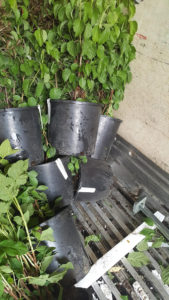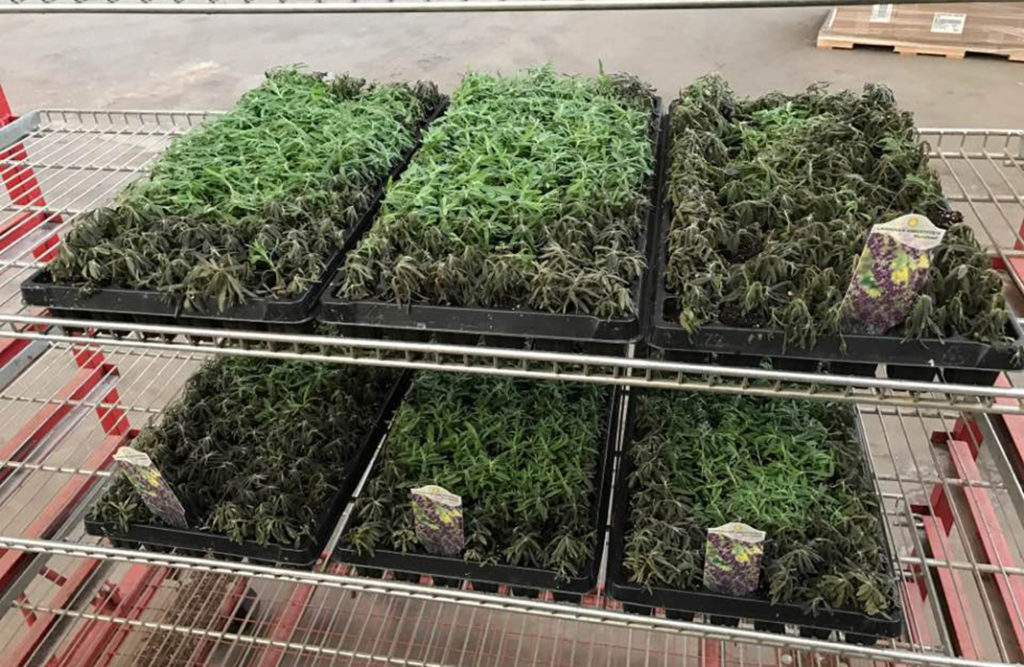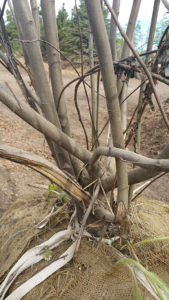The delivery of plants in poor condition may be relatively rare, but dealing with shipping issues can cut into valuable staff time and leave wholesale customers short on plants. While most issues can be solved with relatively little direct financial loss to the customer, some less common issues can cost tens of thousands of dollars.
“When inventory is low, shipping becomes a bigger issue,” said Little Valley Wholesale Nursery Purchasing Manager Kerri Dantino. “We’re trying to work with growers. If a tree has a minor flaw that might have been rejected in the past, we try to give it a chance to heal over, or do more pruning and care on this end than we did in the past, so we can have enough trees to sell. We don’t sell B-grade plants, so if we can’t fix minor flaws, we donate those plants or chip them and make mulch.”

Growers are cooperative in providing credits for damaged plants, but their customers are left searching for replacement plants. Plus, freight costs, which are often paid to contractors, are not always refunded.
“The hardest part is shipping from out-of-state vendors, where it can cost $3,000 for freight. We usually don’t ask for a freight credit from vendors. We asked for that once in the four years I’ve been here,” Dantino said.
Dutch Heritage Gardens Head Grower Brian Austin agreed the actual cost of shipping issues is minimal if issues are discovered quickly. “A lot of times we are notified of incoming issues before they come in the door, especially with young plants. If they find a virus when cutting stock

or if it is found at customs, the vendor will tell us. Even if they are late to ship because a crop is not on schedule, they’ll let us know in advance. With all the technology being used these days, shipping surprises should be decreasing,” Austin said.
The real costs of discovering damaged plants is time in finding and receiving replacements. “Sometimes replacements are not available and we’re forced into ordering alternative plants. If we’re doing combos and one part of the combo is damaged and there are no replacements for it, then we have to work around a problem like that,” he added.
Shipped plants with diseases or insects that are not identified before entering the greenhouse have the costliest consequences. “If we don’t catch it and it spreads to other crops in the greenhouse, then you can go from a $200 loss, which you will be credited for, to $20,000 in crop loss in a worst-case scenario. That’s where it really hurts us. By the time we notice the issue, the company that shipped the product is not willing to cover the loss of three acres of greenhouse, and your own business has to eat that cost and spend a little more of your own money to clean it up,” he said.

Damaged trees, shrubs, and perennials
Shipping issues seem to happen much more frequently with balled and burlapped (B&B) trees than with shrubs and perennials, though perennials can be fragile, too, Dantino said. “Trees are much larger, are handled more and therefore more susceptible to damage. Deciduous are more easily damaged than coniferous. Smooth barked trees are highly susceptible to damage, whereas a tree like a Burr oak is not scratched as easily,” she explained.
Packing B&B trees on trucks can be difficult, providing many opportunities for damage. Branches can become tangled and stacks can fall over.
Little Valley purchases from one B&B grower that used to send trucks with double-stacked trees. “It took too long to unload, and trees were being damaged as they were being taken off. We were willing to pay a little more freight to avoid those problems,” she said.
Another grower sent a shipment of trees that were unloaded with a bunch of scrapes on the trunks. The trees were shipped bound in corrugated pipe to protect them and keep them stable, but it was wrapped so tightly around the trees that removing it caused a lot of damage. “In that case, it took some brainstorming to figure out how to prevent damage in the future, like using a different type of material as a stabilizer,” she said.
At her nursery, all B&B trees tend to come in when there is still a threat of extremely cold temperatures. Trees on refrigerated trucks have more stable temperatures and are more protected than ones that arrive on flatbed trucks. One yearly shipment of conifers that ships on a flatbed always seems to come over I-70 when it is snowing. Even though covered with a tarp, the trees are always splattered with mag chloride when they arrive and need to be rinsed off with a hose to avoid damage.
Dantino can’t remember a time when any dead plants arrived. Other than damage in transit, some plants arrive dry and have to be watered immediately. Very rarely do ugly plugs and liners come in that are rejected and require replacements. Disease and pest issues are also rare. “Generally, if it’s something we can treat with success, then we’ll pull it off to the side and treat it here. We might get a small amount of credit from a vendor to pay for chemicals and labor. If it’s a viburnum or other plant that we know will completely defoliate and not be viable if sprayed, we will reject them and ask for a full credit,” she said.

Disease & pest issues, temperature damage & shortages
Austin of Dutch Heritage Gardens said the most common greenhouse plant pests he sees are the smaller insects like spider mites, thrips, white flies and fungus gnats. “Those are hard to scout for on products going out, and there’s not really a systemic pesticide or treatment for them, so they tend to hitchhike the most,” he said.
It seems like every year a different supplier ships a virus or bacteria that is hard to detect early. Spring is when everyone is shipping the most product, and contaminated plants show up more often because they slip by.
“A lot of times products like unrooted cutting material are ordered from an international producer from somewhere like Africa or Guatemala. They are constantly testing the mother stock, and if they do come back with positive test results, they look at all shipments for that week and notify us about the potential problem with that shipment. They do a pretty good job of tracking and usually notify us before it arrives so we can throw it away immediately,” he said.
His greenhouse began implementing a new protocol last year to head off pest and disease issues with unrooted cuttings. Adopting the practice learned at a grower summit from Battlefield Farms in Virginia, the greenhouse dips the whole cutting into a rooting hormone and organic solution that covers the entire plant, sterilizing it and killing eggs and insects before planting in the greenhouse. It’s easier and more effective than spraying later, and can be done during the transplanting process.
But, the more common shipping issues that he sees are temperature damage, physical breakage and shortages where the shipment contains less than the number purchased. “Shortages are rare, but we still have to check for them,” he explained.
All of the physical damage to plants is caused by how they were loaded. Damage can happen when plants are packed too tightly, too loose or not secured. Soil on the floor of the truck is a big red flag that you should check for damage.
Wilted, droopy, burned, or frozen leaves from cold and heat damage are usually the biggest issues. Heat is not as big of an issue in Colorado as other states like Texas, but can still be a problem in non-refrigerated trucks if plants are touching the inside walls that are heated by the sun.
More sensitive products like poinsettias and young plants need the protection of refrigerated trucks, or at least well-insulated boxes with cooling packs, to avoid temperature swings, said Austin, adding that watering well before shipping also helps ensure delivery of healthy plants. “You can spend eight weeks growing a product and it can take just eight seconds during shipping to destroy it,” he concluded.

Three Steps to Reducing & Addressing Shipping Issues
Step 1: Vendor Communication & Ordering
- Establish relationships with reputable vendors, get to know their shipping practices and understand their guarantee policies.
- Communicate about your expectations for shipping and quality from the beginning.
- When in doubt about the quality of products before shipping, ask for photos. If photos do not tell you enough, spend the extra money to send a staff person to the grower to check on quality. The cost of the travel and hotel stay will be less expensive than receiving a whole shipment of poor quality products.
Step 2: Loading & Transport
- Vendors need to train staff, especially new hires, to load and pack plants carefully, even during the busy shipping season.
- If trucking contractors have any part in loading, they should be made aware of proper handling methods.
- Packing methods that better secure the plants in place, such as shrink wrapping racks, go a long way in avoiding damage from loose branches rubbing and breaking.
Step 3: Unloading
- Wholesale customers should unload carefully to avoid new damage to plants.
- Inspect young plants and large shipments by a grower or quality control staff person with more in-depth knowledge of pests and diseases.
- If plants look damaged or a shortage is noticed, put them off to the side for further inspection by trained staff.
- Consider whether the problem can be fixed or whether the plant is a loss and a credit is necessary.
- For losses, take photos of the plants with tags/labels as well as packing slips, and send to vendors when requesting the credit so they have the information to help them avoid similar problems in the future.










